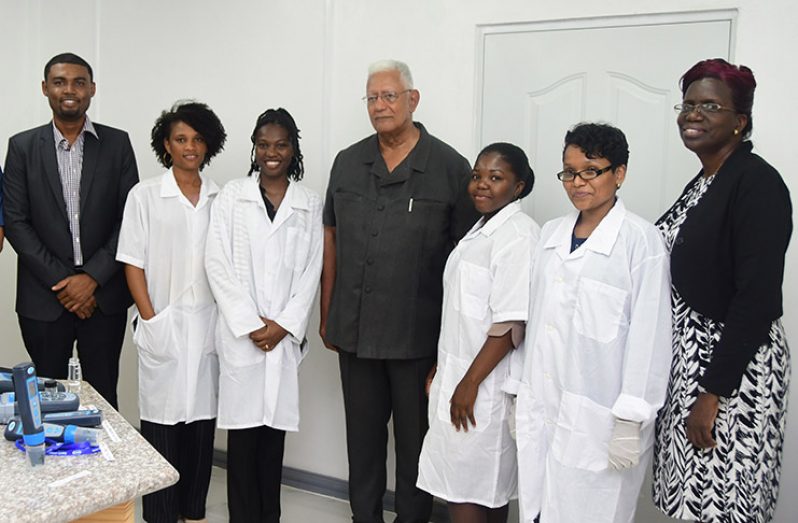By Tamika Garnett
THE Ministry of Agriculture (MoA) Hydrometeorological (Hydromet) Service, on Wednesday, opened the country’s first Water Quality Laboratory in its Brickdam, Georgetown compound.
The $83 million project which included the construction of a 900-square foot three-story building was officially commissioned by Agriculture Minister, Noel Holder on Wednesday afternoon.
The laboratory is seen as a critical step in ensuring the consistent monitoring of the water of Guyana’s surface and ground water resources, for the creation of strategies for improved quality.

Minister Holder underscored the importance of monitoring water quality, noting that it was vital to ensure sustainability of the resource as well as to combat the effects of pollution. It was also important for creation of evidence-based strategies, based on data from research.
“The response to water quality degradation includes research, policies, technologies and the implementing of good practices. Strong data systems are required to understand the issue, its geographical extent and what plans and programmes are required to address these,” Holder noted as he presented remarks at the commissioning ceremony.
The laboratory will function to collect, monitor, analyse, assess and record the availability, quality, and use of Guyana’s surface and ground water resources.
This allows for the creation of a comprehensive database on the quality of the country’s water resources.
“Today marks an important milestone for the Hydrometeorological Service with respect to the department fulfilling its mandate with regard to water resources management, and specifically with regard to the monitoring of the quality of the country’s water resources,” Holder said.
The Water and Sewerage Act 2002 confers upon the Hydromet the responsibility to manage and operate national systems to monitor the availability, quality and use of Guyana’s surface and ground water resources; and assess and record the impact of water use on the quality and quantity of surface and ground water.
Prior to the opening of the laboratory, the Hydromet was carrying out this mandate with bare minimum resources and under questionable standards.
“Today marks the thrust towards establishing a national water quality monitoring network and the establishment of a central repository for all information on the quality of the country’s resources. Hydromet is essentially the custodian of all of Guyana’s waters. The ownership of the country’s water is vested in the State and the Hydrometerological Service has been given the responsibility to manage this resource for the state,” Holder noted.
To start off, the facility will be staffed by four hydro-chemists, who are all Natural Science graduates. The building includes separate rooms for chemical analysis, biological analysis and the weighing of samples. The laboratory was so designed to allow for future expansion, should such a need arise.
LANDMARK DEVELOPMENT
The opening of the laboratory marks a landmark in the massive advancement that the Hydromet Service has seen since its establishment in 1965, with the mandate to monitor and evaluate the weather and water resources in Guyana.
Chief Hydromet Officer, Dr. Garvin Cummings, recalls the less than favourable conditions at the laboratory prior to 2016 when the Ministry of Finance finally granted funding for the establishment of the vital facility.
“When I joined the Service in 1997 as hydrological technician, water quality testing was done in a small and very unattractive room on the ground floor of our building. We had a small piece of equipment, a manual for its operation, much of which we didn’t quite understand, and a whole lot of reagents. There was no formal training in anything having to do with water quality testing. We just tested water samples the best way we knew how and in a very haphazard way… just trying to do the job the best way we knew,” he shared.
The poor standards of the previous laboratory discredited the dependability of any data garnered being useful for any substantive scientific analysis, assessment or reporting, or its use in generating policies towards improved water quality.
“It is out of this history of water quality testing at Hydromet that the vision for a better environment, improved expertise and an approved and transparent system for water quality testing was conceived… where our results can be used to inform local, regional, national and even transboundary decision-making in support of sound water resources management,” Dr Cummings said.
Felicia Persaud, one of the four hydro-chemists who will be managing the facility, emphasised the importance of water quality monitoring.
“Monitoring water quality is an important part of helping us determine whether or not we are making progress in cleaning our water ways. Changes in water quality affect not only economic and social welfare but also the sustainability of vital environmental flow, ecosystems and biodiversity. Scientific discovery and monitoring are critical to ensuring the sustainable health of the water bodies we enjoy. Long-term observation of contaminants is critical to better understand how changes in land use management are impacting the water quality,” she said.
Also delivering remarks at the ceremony was MoA Permanent Secretary, Delma Nedd, who highlighted the need for structuring of improvement policies based on evidence garnered from research carried out.
She delivered the closing remarks and vote of thanks.




.jpg)










